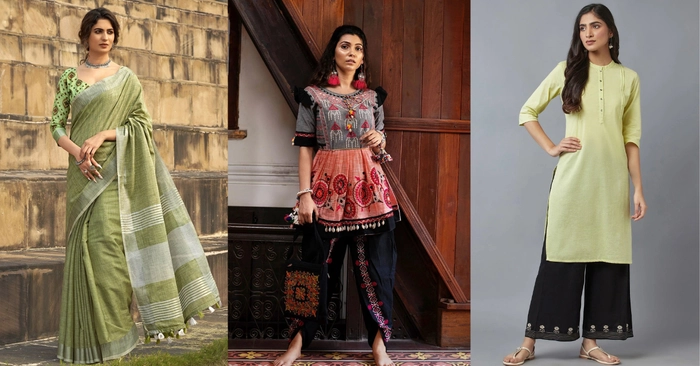In the sphere of fashion, there is a meticulous fabric that has preserved and blended into style and sustainability – Khadi. The fabric is not only the backbone of the Indian freedom struggle but also fortifies eco-friendly fashion and cultural pride. Admiringly, khadi ethnic wear does not only serve as a fashion statement, but rather, for those who appreciate khadi, it serves as a gentle reminder that tradition, comfort, and caring for the environment can coexist.
The Rich History of Khadi
From Freedom Movement to Fashion Statement
The journey of Khadi commenced as a strong emblem representing India’s relentless struggle towards independence. The father of the nation, Mahatma Gandhi, handspun and wove this fabric single-handedly, using it as a tool to promote economic self-reliance. It served as a peaceful protest against the rule of the brutal British. What initiated as a political movement has shifted into a global fashion statement, with khadi poised to find its place in every wardrobe across the globe.
Protecting Cultural Heritage
Wearing Khadi serves as a mark of remembrance toward our roots. The cloth is woven by hand and tells the tales of skilled laborers, preserving stories of this heritage. Choosing khadi ethnic wear means that wearing beautiful clothes is accompanied by preserving rich heritage legacy.
The Uniqueness of Khadi
Irreplaceability of Comfort
It is true that khadi is synonymous with comfort since it has a remarkable touch to it. The fabric's unique crepe structure allows it to be worn all year round due to harnessing air circulation. The wearer is to stay cool in the summer and be protected with warmth during winters. Ethnic khadi apparel has proven to serve as year-round fashion.
Sturdiness and Shrinkage
Khadi becomes an appealing commodity due to its renown for being long-lasting and its timeless span of styles. With proper care, khadi garments can last for decades since the apparel is known to age gracefully and turn softer with every wash. It is true that possessing khadi in one’s collection is beneficial, aligned with sustainable fashion, and reduces the need for constant replacement.
Khadi in Contemporary Fashion
The Scope of Creativity in Clothing
Khadi is making a comeback in the fashion world, as designers incorporate it into a wide variety of modern styles, including sarees, denim jackets, and even dresses. Khadi ethnic wear showcases its variety that suits different preferences and functions. The fabric’s natural texture and drape enhance both traditional and fusion designs that are timeless.
Fabric Customization and Personalization
Khadi's customization possibilities are endless due to the various dyeing and printing techniques available. Craftsmen and designers surmount unique patterns and color combinations that guarantee that each piece of khadi fabric is uniquely different. This individual customization aspect enhances the beauty of khadi clothing and makes them highly appreciated by those who cherish different fashion.
Sustainability at its Best
Production and Eco-Friendly Characteristics
Unlike the rest of the fabrics in the world, khadi fabric is a gift to humanity in a world that focuses on fast fashion. Khadi fabric stands out as a beacon of sustainability and relies on minimal energy and machinery to produce, resulting in a significantly lower carbon footprint as compared to industrialized textile manufacturing. The eco-friendly angle of khadi production is perfectly in tune with the rising global concern about sustainable living.
Supporting Local Economies
It is socially responsible to choose khadi ethnic wear as fashion. Millions of artisans, particularly in rural areas, are employed in the khadi industry. Consumers supporting khadi help in earning the basic livelihood of skilled craftspeople and are helping preserve traditional skills while promoting economic self-sufficiency in local communities.
Caring for Your Khadi Garments
Gentle Maintenance for Lasting Beauty
Your khadi garments will last a long time if they are maintained properly. To maintain the natural texture and color of the fabric, it is advisable to hand wash in cold water with a mild detergent and avoid the use of harsh chemicals. Machine drying should also be avoided and clothes should be air-dried in the shade instead. With the right maintenance, khadi ethnic wear will remain beautiful and comfortable for years to come.
Embracing Natural Aging
Khadi is known for many distinct attributes, and one of them is how it matures with time. Khadi garments over time develop a soft patina, making them even softer and more suited to the wearer. This natural aging process gives khadi clothing extra appeal, ensuring every piece is cherished in your wardrobe.
The Future of Khadi Fashion
Traditions Merging With Innovations
Khadi is still advancing as we look towards the future. Fashion designers and textile technologists are weaving new methods of integrating modern approaches into khadi’s traditional weaving methods while preserving khadi's character, boosting its properties. These advancements will further enhance the versatility and appeal of khadi for global audiences.
Global Recognition
Khadi is losing its appeal within its boundaries and gaining as a global trend. International designers and fashion houses are khadi’s latest audiences. They seem to appreciate Rabari handicraft and their woven fabric works as one of the signature pieces in their design collection as well as on international catwalks. This increasing global attention is aiding khadi in gaining recognition as a sustainable premium fabric globally.
To summarize, khadi ethnic wear epitomizes a remarkable combination of heritage, craft, and fashion. As we shift towards a more mindful approach to clothing, khadi emerges as a fabric that does not only beautify but also breathes life into its wearer. At FabPotli, we take pride in showcasing the finest craftsmanship in khadi as well as the style and elegance that khadi offers, offered through our collection of contemporary ethnic wear. Opting for khadi not only enables us to dress with ease and elegance but also fosters a sustainable ecosystem rich in culture and heritage.

